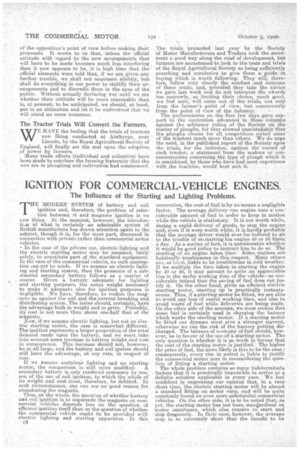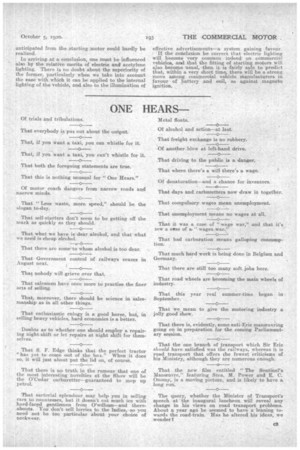IGNITION FOR COMMERCIAL-VEHICLE ENGINES.
Page 2

Page 3

If you've noticed an error in this article please click here to report it so we can fix it.
The Influence of the Starting and Lighting Problems.
THE MODERN YSTEM of battery and coil ignition and, therefore, the problem of selection between it and magneto ignition is no row thin.. At the moment, however, the introductien 'of what is certainly. an admirable system .cif, Britieh manufacture has drawn attention again to the subject,. though it is, for the most part, discussed in connection with private rather than commercial motor. vehicles,
• In the case of the private car, electric lighting and the electric starting motor may be assumed, fairly safely, to constitute part of the standard equipment. In the ease of the commercial vehicle, no such assumption can yet be made. If we assume an electric lighting and starting system then the presence of a sub-. stantial secondary battery follows as a matter of course. Given a battery adequate for lighting and starting purpbses, the extra weight necessary to make it adequate also for ignition purposes is negligible. We have; therefore, to reckon the magneto as against the coil and. the current breaking and distributing system. The latter should, certainly, have the advantage bath in weight and in price. Probably, its cost is not more than about one-half that of the magneto.
Now, if we assume electric lighting, but not an electric starting motor, the case is somewhat different. The ignition represents a larger proportion of the total demand made upon the battery,. and we must take into account some increase in battery Weight and cost in consequence. This increase 6hould not, however,. be at all large, and the battery and coil system should still have the advantage, at any rate, in reapect of cost.
If we h.astuite acetylene lighting and no starting
motor, the comparison is still more modified. A. secondary battery is only rendered necessary by reason of the use of coil ignition, to which the whole of its weight and cost, must, therefore, be debited. In such circumstances, one can see no good reason for, abandoning the magneto.
Thus, on the whole, the question of whether battery mad coil ignition is to supersede the magneto on commercial vehiele.s depends less on the question of efficient ignition itself than on the question of whether the commercial vehicle. ought .te be provided with electric lighting and starting apparatus. In this
connection, the cost of fuel is by no means a negligible factor.. The average delivery van engine uses a. considerable amount of fuel in order to keep in motion while the vehicle iA stationary; It in not worth while, during a rapid delivery of goods,. to stop the engine and, even if it were worth while, it is hardly probable that the average driver would evereh-e induced to go to the tremble of re-starting his engine 40 or 50 times a day. As a matter of fact,. it is questionable whether it would be good. Policy to Instruct him to do so. The starting of an engine takes time. Some engines are habitually troublesome in this respect. Many others are, at lcst. liable to be troublesome in cold weather.. If we multiply the time taken in starting the engine by 40 or 50, it May amount to quite art appreciable loss in the useful working time of the vehicle—so considerable indeed that the saving of fuel does not. jus,, .tify it. On the other 'hand, given an efficient electric starting motor, starting up is practically instantaneous. Thus, if a starting motor be fitted, we are ableto avoid any lose of useful working time, and also to avoid waste of fuel while deliveries. are being made. On the other side of the account, we must reckon that some fuel is certainly used in charging the battery which works the starting motor. If a, startingmotor be fitted our dynamo must give a stronger current, otherwise we rim the risk of the battery getting dis-• charged. The balance, of economy of fuel should, however, be in favour of the use of a starting motor. The only question is whether it is so m.ualt in favour that the east of the.starting Motor is justified. The higher the price of fuel, the more likely is this, tobe the ease ; consequently, every rise in petrol is liable to justify the commercial Motor user in reconsidering the question of fitting a starting motor. ' The whole problem contains so many indeterminate factors that it is practically impossible to arrive at a definite solution applicable in every case. We feel confident in expressing our opinion that, in a, very short time, the electric starting motor will be almost a standard fitting on motor vans, and will be quite commonly found on even more substantial commercial vehicles. On the other side, it is to be noted that, as yet,the, starting motor has not been standardized on motor omnibuses, which also require to -start and stop frequently. In their case, however, the average stop is so extremely short that the benefit to be -anticipated from the. starting motor could hardly be realized.
In arriving at a conclusion, one must be influenced also by the relative merits of electric and acetylene lighting.There is no doubt about the superiority of the former, particularly when we take into account the ease with which it can be applied to the internal lighting of the vehicle, and also to the illumination of effective advertisements—a system gaining favour. if the conclusion be correct that electric lighting will become very common indeed on commercial vehicles, and that the fitting of starting motors will also become usual, then it is fairly safe to predict that, within a very short time there will be a strong move among commercial vehicle manufacturers in favour of battery and coil, as against magneto ignition.




















































